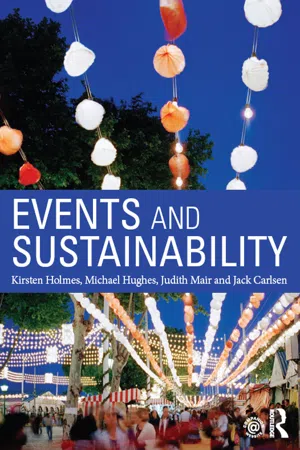
- 206 pages
- English
- ePUB (mobile friendly)
- Available on iOS & Android
Events and Sustainability
About This Book
Increasing concerns over climate and environmental change, the global economic and financial crisis and impacts on host communities, audiences, participants and destinations has reinforced the need for more sustainable approaches to events. Sustainability now features as part of the bid process for many mega-events, such as the Olympic Games, as well as significant regional and local events, where the event organisers are required by funding bodies and governments to generate broader outcomes for the locality.
This book is the first to offer students a comprehensive introduction to the full range of issues and topics relevant to event sustainability including impacts, operating and policy environments, stimulating urban regeneration and creating lasting legacies, as well as practical knowledge on how to achieve a sustainable event. Taking a holistic approach drawing on multidisciplinary theory it offers insight into the economic, socio-cultural and environmental impacts and how these can be adapted or mitigated. Theory and practice are linked through integrated case studies based on a wide range of event types from mega events to community festivals to show impacts, best practice and how better sustainable practice can be achieved in the future. Learning objectives, discussion questions and further reading suggestions are included to aid understanding and further knowledge; additional resources for lecturers and students including power point slides, video and web links are available online.
Events and Sustainability is essential reading for all events management students and future managers.
Frequently asked questions
PART I The events context
Chapter 2 The internal and external environment for sustainable event organisers
- Understand the complex environment within which event organisation takes place
- Analyse the internal and external environments for event organisers
- Identify tools for analysing the contexts within which event organisation takes place
- Conduct a stakeholder analysis for use by event organisers
- Identify the constraints and limits to organising sustainable events
Introduction
The internal environment of an event

People
Information technology
Equipment
Materials
Space
- The centre began recycling material in 1998 and now recycles nearly 2 million pounds of material annually.
- Their exclusive caterer, SAVOR, composts all organic waste from their kitchens and donates unused food to local not-for-profit organisations and also uses biodiesel fuel in their delivery vans.
- Moscone West, an extension to the complex completed in 2003, features low emission glass to reduce energy loss.
- The Moscone Centre employs a full-time air quality technician to continually monitor air quality.
- In 2004, the centre installed solar panels on the roof which generate enough power for 500 homes.
- The centre also installed energy efficient lighting and lightbulbs, which reduced energy consumption from lighting in the first year by up to 20 per cent.
- Contractors of major projects are required to track and report their recycling and disposal of waste generated by the project.
- The centre is located in the centre of San Francisco, close to local and regional transport and within walking distance of 20,000 hotel rooms, which enables event planners to minimise transport emissions generated by their event.
Vehicles
Time
Scope of the event
- Demographic scope. Who is associated with the event in terms of visitor profiles, business community members, staff and volunteers, competitors and performers, stakeholders, sponsors and partners? Should non-attendees within the event host destination be considered by the event organisers, or only those directly involved in the event?
- Geographic scope. What are the spatial boundaries of the event and the associated economic impacts? Mobile events pose a particular challenge in this regard, whereas the boundaries for static events are more easily established. Do event destination and tourism destination boundaries coincide?
- Temporal scope. Over what time frame will event impacts be generated? Again, events with a defined duration (such as sporting competitions and music festivals) are more easily assessed than those occurring over longer periods (such as art exhibitions). Similarly, visitor profiles can vary greatly between weekends and weekdays, so not all event days can be expected to generate the same impacts and outcomes. Some major events can also have a legacy that encourages increased numbers of people to visit the destination long after the event ends. The legacy that events leave behind is discussed in detail in chapter 12.
- Economic scope. Visitors’, organisers’ and stakeholders’ expenditure at events can vary greatly in terms of incidence and impact, depending on the extent to which event inputs are sourced locally or imported and the extent to which regional, state or territorial, or national economies are affected by the event.
Understanding the internal and external environment of an event
- Political – To what extent do the local, regional and/or national governments support and influence the event?
- Economic – What economic factors affect the costs and revenues of the event, such as the inflation, interest and exchange rates?
- Social – What are the different cultural and ethnic groups within the host population and what relationships do the event organisers need to foster with these groups?
- Technological – What technologies are available for organising, managing, staging, monitoring and evalu...
Table of contents
- Cover Page
- Half-Title Page
- Series
- Title Page
- Copyright Page
- Dedication
- Table of Contents
- List of figures
- List of tables
- List of boxes
- About the authors
- Preface
- Part I The events context
- Part II Impacts of sustainable events
- Part III Logistics of sustainable events
- 12 Creating sustainable legacies from events
- Part IV Conclusion
- Glossary
- Index